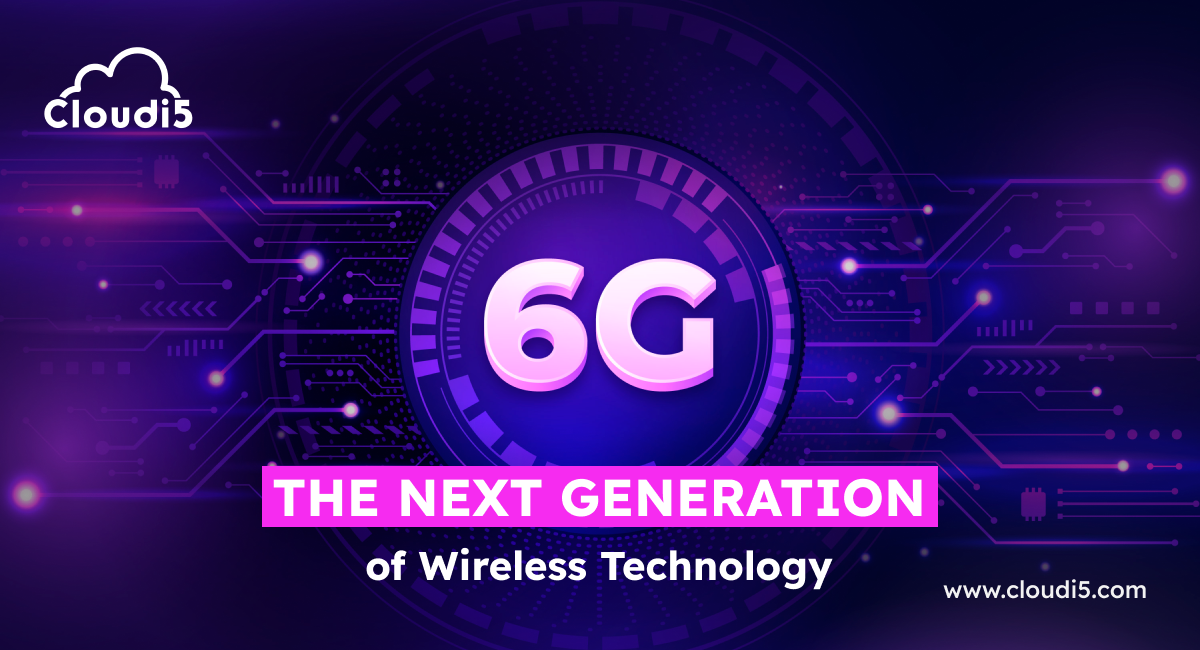
6G: The Next Generation Of Wireless Technology
Recall how downloading music took more time than the song itself? Excellent times, right? Fortunately, those days are gone. Though let's be honest: we're still waiting for the day when our devices might download an entire Netflix series in less time than it takes to drink a glass of water. 5G has given us a taste of internet heaven.
It's amazing how quickly 5G's superfast data rates replace 1G's straightforward voice calls. Every generation of mobile technologies has produced notable increases in speed, coverage, and device connecting capability. For example, 5G provides low latency and lightning-fast bandwidth so we may connect numerous devices at once.
But even 5G is starting to seem like old news as our ravenous need for speed and connectivity increases. Faster data speeds, reduced latency, and the possibility to link billions of devices at once demand more than 5G can provide strains on its capabilities. Here's where 6G finds application. Expected to be the next major leap in wireless technology, 6G has the power to fundamentally alter our lives and workplaces in ways we are not yet entirely certain about.
What is 6G?
The sixth version of cell phone technology is coming soon and is called 6G. Think of it as the next big step forward in radio communication. It could change the way we live and work. It is meant to be faster, more reliable, and able to connect a lot more devices than 5G that came before it.
Key Characteristics of 6G
- Speed: Rates of terabits per second are projected with 6G. That's a thousand times faster than the fastest internet connections we have now! This includes things like quickly getting big files, watching 4K video without buffering, and more.
- Latency: Latency is the amount of time it takes for data to move from one place to another. 6G aims for almost no delay, which means that reaction times are almost instantaneous. This is very important for things like virtual reality, driverless cars, and remote treatment.
- Capacity: 6G will be able to connect a lot of gadgets at the same time. This is very important for the Internet of Things (IoT), which will link billions of devices to the web.
- Reliability: 6G wants to offer service that doesn't stop. It tries to provide a strong and stable link all the time, even in busy areas or remote areas.
6G vs. 5G
|
Feature |
5G |
6G |
|
Speed |
Multi-gigabit per second |
Terabits per second |
|
Latency |
Milliseconds |
Near-zero |
|
Capacity |
Massive connectivity |
Even more massive connectivity |
|
Frequency Bands |
Low-band & mmWave spectrum |
Higher frequency bands (including terahertz) |
|
Other Features |
Standard features |
Advanced features (network slicing, AI, enhanced security) |
How Does 6G Work?
6G is an innovative technology that employs many advanced methods to deliver high-speed internet and facilitate the connection of numerous devices. Below is a concise elucidation of its functionality:
Key Technologies Used in 6G
Higher Frequency Bands:
- Explanation: 6G will make advantage of ultra-high-frequency communications, above those used in 5G. These frequencies offer a great capability for concurrently handling big volumes of data.
- Challenges: Because these high frequencies have a short range and are easily messed up, they might make it harder to send. Experts need to come up with new antennas and ways to send signals to make sure the messages get to where they go.
AI and Machine Learning:
- What It Means: Machine learning and artificial intelligence (AI) will help make 6G networks better. They can look at how people use the network, guess what will happen next, and make changes automatically to make sure everything works well.
- Advantages: The network will be faster, less crowded, and better able to use energy.
Advanced Antenna Systems:
- What it Means: For 6G, new receivers will be used that can focus signals more accurately and handle more than one data stream at the same time.
- Advantages: This will make it easier to handle the high-frequency data and boost speed all around.
Network Slicing:
- What it Means: With this technology, the network is split into different "slices," or parts. Each slice can be changed to fit a different purpose, such as one for self-driving cars and another for normal viewing the web.
- Advantages: Also, it makes sure that each service has the right amount of protection and tools.
Challenges and Solutions
Propagation Challenges:
High-frequency messages can't go very far and can get stopped by things in their way. Engineers are working on fresh ways to fix these problems.
Device Miniaturization:
Things that work with these high frequencies but are also small and easy to carry around are hard to make. To deal with this, researchers are making new equipment.
Massive Data Management:
All of the info that comes from 6G will need to be handled and kept track of. To do this, you need modern technology and smart ways to handle your data.
Standardization:
Standards need to be set around the world so that 6G works well everywhere. This makes sure that networks and gadgets from different places can easily connect and work together.
Even with these problems, things are moving forward. Scientists and engineers are making big steps forward in antennas, data processing, and materials. This is getting us closer to having 6G.
The Impact of 6G
Many parts of our lives and businesses are going to change a lot because of 6G. Take a look at what 6G could do:
Potential Uses of 6G
1. Telemedicine:
6G will make health care a lot better. Robotic tools will make virtual meetings clearer and more thorough, which will help more people get medical advice. Doctors will be able to do remote surgeries with great accuracy.
2. Autonomous Vehicles:
With 6G, self-driving cars will work better. To keep everyone safe and make driving faster, they'll be able to talk to each other, to traffic lights, and even to people on the sidewalk.
3. Augmented and Virtual Reality (AR/VR):
The best AR and VR experiences will get even better with 6G. It will give you very clear images and quick responses, which will make games, movies, and virtual training feel more real.
4. Smart Cities:
6G will make towns run better. It will make better decisions about things like traffic, energy use, and public safety, which will make life in cities safer and more efficient.
5. Industrial IoT (Internet of Things):
6G will make it easier for smart tools to work together in factories and other businesses. This will help with things like keeping machines in good shape so they don't break down and making companies run better.
Economic and Social Effects
1. Economic Impact:
New jobs and business chances will open up because of 6G. It will make businesses run better and help the market grow.
2. Social Impact:
People who live in remote places may be able to get to services like schooling and health care more easily with 6G. It can also make life better in general.
Challenges to Consider
- Data Privacy: This is important because we need to keep private data safe.
- Cybersecurity: We'll need to protect ourselves from hackers and other online threats.
- Digital Divide: We need to make sure that 6G helps everyone, not just people who are already linked.
Overall, 6G could make our lives easier and connect us more, but we'll have to be careful about how we deal with some problems to get the best results.
6G: The Challenges Ahead
It's hard to make 6G happen! It's like making a very fast highway, but a lot harder. Techies need to figure out how to send data very quickly without losing it or making it take too long to receive. Also, phones and other tech must be very smart to handle that speed.
6G is being made possible by smart people in colleges, big businesses, and the government working together. The rules for who can use what frequencies are set by the government. Companies build the towers and phones, and smart people figure out how to make it all work.
Sixth-generation phones won't come out for a few more years, maybe until 2030. But everything will be different when it comes! Cars that drive themselves, surgery done by doctors far away, and even things we can't think of yet are possible.
6G is what's next. We'll have more fun, less stress, and feel safer.
Conclusion
6G is not just an improvement; it's a big shift. We are about to start a new era of technology that will give us lots of great options. Even though there are still some problems, the benefits that could come from it are huge. People all over the world could live better lives with 6G because it could change healthcare, transportation, entertainment, and education. We can look forward to a future with more connected gadgets and smoother experiences as we work on 6G. Getting to 6G will be hard, but the benefits will be great.
Trusted By












Leave Comments